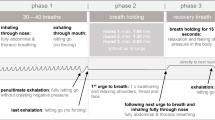Abstract
Objective. The present study was aimed at determining the relative influences of tidal volume and thoraco-abdominal separation (relative thoracic and abdominal contribution to the tidal volume) on the respiratory induced intensity variation (RIIV) of the photoplethysmographic signal. The effects were studied in two body positions. Methods. Respiratory inductive plethysmography was used for quantifying thoraco-abdominal separation and for assessing tidal volumes. 10 subjects were trained to perform widely varying degrees of thoraco-abdominal separation at different tidal volumes. The relationship between the RIIV signal peak-to-peak value (measured at the forearm), and the tidal volume and thoraco-abdominal separation was investigated in two body positions with the use of multiple linear regression. Results. Larger tidal volume and more thoracic contribution to respiration were found to increase the RIIV peak-to-peak value (p< 0.0005). In the supine position, the tidal volume influence was stronger than that of thoraco-abdominal separation, and in the sitting position, the opposite was seen. Conclusions. The effects on the RIIV signal following changes in thoraco-abdominal separation and tidal volume are of the same order of magnitude. In the supine position, the influence of thoracic versus abdominal contribution to the tidal volume is not as significant as in the sitting position. Photoplethysmography is a promising technique for combined monitoring of several respiratory parameters, including tidal volume. In situations where the relative thoracic and abdominal contributions are likely to vary, the tidal volume information becomes less reliable.
Similar content being viewed by others
REFERENCES
Challoner AVJ. Photoelectric plethysmography for estimating cutaneous blood flow. In: Rolfe P, ed. Non-invasive physiological measurement. London: Academic Press 1979
Murray WB, Foster PA. The peripheral pulse wave: Information overlooked. J Clin Monit Comput 1996; 12: 365–377
Penaz J. Mayer waves: History and methodology. Automedica 1978; 2: 135–141
Tremper KK, Barker SJ. Pulse Oximetry. Anesthesiology 1989; 70: 98–108
Eldrup-Jorgensen S, Schwartz AI, Wallace JD. A method for clinical evaluation of peripheral circulation: Photoelectric hemodensitometry. Surgery 1966; 59: 505–513
Lindberg L-G, Ugnell H, Öberg PÅ. Monitoring of respiratory and heart rates using a fibre-optic sensor, Med Biol Eng Comput 1992; 30: 533–537
Johansson A, Öberg PÅ. Estimation of respiratory volumes from the photoplethysmographic signal Part 1: experimental results. Med Biol Eng Comput 1999; 37: 42–47
Cohn MA, Rao ASV, Broudy M, et al. The respiratory inductive plethysmograph: A new non-invasive monitor of respiration. Bull Eur Physiopathol Respir 1982; 18: 643–658
Strömberg NOT, Grönkvist MJ. Improved accuracy and extended flow range for a Fleisch pneumotachograph. Med Biol Eng Comput 1999; 37: 456–460
Strömberg NOT, Dahlbäck GO, Gustafsson PM. Evaluation of various models for respiratory inductance plethysmography calibration. J Appl Physiol 1993; 74: 1206–1211
Gonzalez H, Haller B, Watson HL, Sackner MA. Accuracy of respiratory inductive plethysmograph over wide range of rib cage and abdominal compartmental contributions to tidal volume in normal subjects and in patients with chronic obstructive pulmonary disease. Am Rev Respir Dis 1984; 130: 171–174
Nilsson L, Johansson A, Svanerudh J, Kalman S. Is the respiratory component of the photoplethysmographic signal of venous origin? Med Biol Eng Comput 1999; 37(Suppl 2): 912–913
Strömberg NOT, Gustafsson PM. Breathing pattern variability during bronchial histamine and methacholine challenges in asthmatics. Resp Med 1996; 90: 287–296
Brecher GA. Venous Return. New York: Grune & Stratton 1956
Moreno AH, Burchell AR, van der Woude R, Burke JH. Respiratory regulation of splanchnic and systemic venous return. Am J Physiol 1967; 213: 455–465
Johansson A, Öberg PÅ. Estimation of respiratory volumes from the photoplethysmographic signal Part 2: A model study. Med Biol Eng Comput 1999; 37: 48–53
Rothe CF. Reflex control of veins and vascular capacitance. Physiological Reviews 1983; 63: 1281–1342
Takata M, Beloucif S, Shimada M, Robotham JL. Superior and inferior vena caval flows during respiration: Pathogenesis of Kussmaul's sign. Am J Physiol (Heart Circ Physiol) 1992; 31: H763–H770
Johansson A, Öberg PÅ, Sedin G. Monitoring of heart and respiratory rates in newborn infants using a new photoplethysmographic technique. J Clin Monit 1999; 15: 461–467
Nilsson L, Johansson A, Kalman S. Monitoring of respiratory rate in postoperative care using a new photoplethysmographic technique. J Clin Monit 2000; 16: 309–315
Author information
Authors and Affiliations
Rights and permissions
About this article
Cite this article
Johansson, A., Strömberg, T. Influence of Tidal Volume and THoraco-abdominal Separation on the Respiratory Induced Variation of the Photoplethysmogram. J Clin Monit Comput 16, 575–581 (2000). https://doi.org/10.1023/A:1012260415191
Issue Date:
DOI: https://doi.org/10.1023/A:1012260415191




